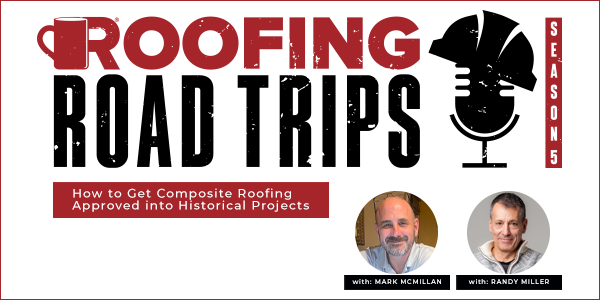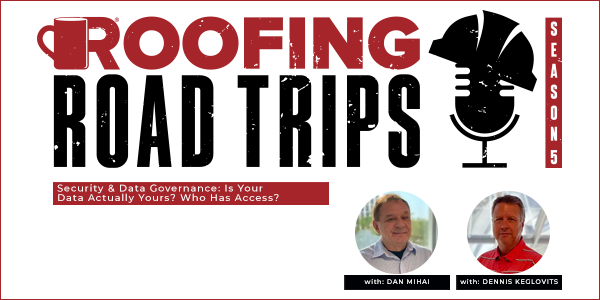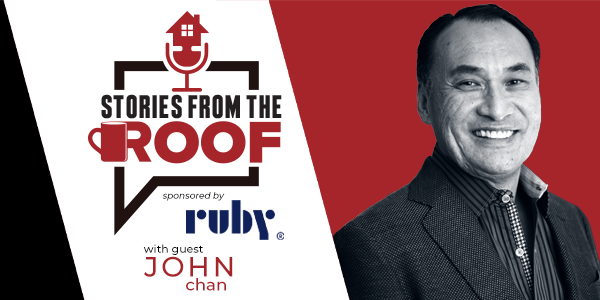How to Get Composite Roofing Approved Into Historical Projects - PODCAST TRANSCRIPTION
August 28, 2023 at 3:07 p.m.Editor's note: The following is the transcript of a live interview with Mark McMillan from Horn Brothers Roofing and Randy Miller from All Right Home and Remodeling. You can read the interview below or listen to the podcast.
Intro/Outro: Welcome to Roofing Road Trips with Heidi. Explore the roofing industry through the eyes of a long-term professional within the trade. Listen for insights, interviews, and exciting news in the roofing industry today.
Heidi J. Ellsworth: Hello and welcome to another Roofing Road Trips from Roofers Coffee Shop. This is Heidi Ellsworth and we have a really interesting roofing road trip today. We're road tripping across the country to talk to some experts in historical projects. I mean, you got to know we all love an amazing historical project to see that roof go on, all the beautiful craftsmanship that goes into it. We want to learn more about that today. We're bringing this to you from our friends at DaVinci, and we are going to really be able to get into it. I want to welcome Mark McMillan with Horn Brothers Roofing and Randy Miller with All Right Home and Remodeling. Welcome, gentlemen.
Randy Miller: Thank you.
Mark McMillan: Hello.
Heidi J. Ellsworth: This is great. I love this kind of stuff. My dad was a general contractor. I love all architecture and historical projects, so I'm really excited to hear what all you are doing. Before we get into that, let's go ahead and start with some introductions. Randy, could you introduce yourself and your company?
Randy Miller: Sure. As you had mentioned, my name is Randy Miller. I am the second generation owner of All Right Home and Remodeling. My aunt and uncle started this business in 1969. We're located in the Milwaukee market, and that's generally the area that we end up working. We do residential roofing, siding, windows, gutters, and insulation.
Heidi J. Ellsworth: Excellent. That is great. Thank you for being here today.
Randy Miller: My pleasure. Thank you.
Heidi J. Ellsworth: Mark, could you introduce yourself and tell us a little bit about your company?
Mark McMillan: Of course. My name is Mark McMillan. I'm the sales manager for Horn Brothers Roofing in Denver, Colorado. Our main market is the Denver area, surrounding areas, and also Telluride, Vail Corridor and Aspen areas. We do a lot of work up in there. We are probably at this point, about 60% commercial, 40% residential. We've been around in the market for about 30 years and our typical projects are more in the high-end products with the synthetics and stuff like that.
Heidi J. Ellsworth: Excellent. Well, I actually have a daughter who lives in Denver, so Mark, I've seen a lot of those beautiful homes and roofs. This is great. Well, what I want to do is I kind of want to take us back. I want to step back a little bit because when I was first coming into the industry, there was a lot of wood, there was a lot of slate, and there still is today, but there's also a lot of opportunities for historical projects to look a little bit different. There's a lot of rules, as you guys are going to share. I wanted to start out there to kind of do a little bit of an overview of the different types of historical registries and designations and regulations. Randy, I know you do a lot of this. Can you give us kind of that big picture overview of really what's happening out there right now with historical registries and designations for the homes you're working on and in your area?
Randy Miller: Sure. We've been fortunate over the years actually. Also, myself, I was an alderman in Cedarburg, a small community in this area that had a historical district in its downtown area, and I was fortunate to be part of that landmark commission of that area to oversee, to make sure that we were doing things and keeping within the appearance and style and looks of what you'd want to end up having in the older historical homes of the area. Also in Milwaukee, we were fortunate to end up getting the Cream of the Cream City award, which was for historical preservation and of course the Frank Lloyd Wright project that we're going to be talking about a little bit here. There are local designation, there is state designation and obviously national registries as well. There's quite a bit of different layers and what the regulations are of the different homes and neighborhoods that are out there that they're trying to preserve and keep within the areas of the way it should be.
Heidi J. Ellsworth: Yeah. That beautiful historical feel and look. When you first go and talk to someone, how do you kind of dive into that? How do you even know if it's historical or not? I mean, obviously besides the architecture, but I know not everything qualifies.
Randy Miller: Right. Homeowners are usually pretty open when they're in a historical district. They've done their research because let's be honest, it takes a certain type of person and personality and very much interest to want to stay and keep and preserve a home of those natures.
Heidi J. Ellsworth: Yeah. It takes some work. I grew up in one, a Victorian house, so a lot of work. As we're looking at things, especially around fire, around weight, structural, all these different issues that are going on, and now having solutions like composite roofing. I love what you said, that the homeowners are doing their research, because we are hearing the exact same thing. What are some of your tips for even talking about this as a viable alternative for a historic roof?
Randy Miller: Well, for one, be patient, because you're talking about in a lot of cases, volunteers that end up being part of those committees. They've gotten a little bit of, let's say, power and authority and in some cases they end up taking it too far. Find out what really is the objection, whether it's in the community or in the homeowner's eyes themselves of what do they want to end up accomplishing as far as in the project?
Heidi J. Ellsworth: Yeah, I think that's great. I mean, because if you have the look, but yet you have a lot of other benefits that are going to be better for the home, that kind of initiative I think can make a big difference for homeowners.
Randy Miller: It can be a win-win scenario for everybody. You want longevity, you want it to end up looking good. You want it to end up keeping in the era. I think in some areas that's kind of been lost of what they've accepted over the years, and some of the homeowners want to go back to that original appearance wise.
Heidi J. Ellsworth: Oh, I love that. Yeah, it's gone a little bit futuristic and now they're bringing it back to the historic value. I love that. Mark, being from Denver, I'm from Oregon, we know we have been just challenged with wildfires throughout the west, and I mean, we're known for some absolutely beautiful wood roofs on a lot of our historic buildings. What are some things that you could add to what Randy's already said and really in the benefits of looking at composite products over some that might be more flammable?
Mark McMillan: Sure. To add on to what we were just talking about, a lot of our homeowners in the landmark area of Denver, we see a lot of them wanting products that from the very beginning, we know people that want to put steel roofs on and things like that, that most of the landmark commissions are not going to allow because it just kind of takes away from the landmark appearance from what they're trying to get back to.
Typically on the flammable side, we had a large wildfire up here through the Boulder Canyon into some of Superior and stuff like that. I think we lost a thousand homes in that fire. It is a big push not only on the types of roof that you're doing, but on how to create ventilation that doesn't make that even a bigger problem. What we see typically is we're trying to get in the landmarks is that to still preserve that look and still have that same feel, but at the same time have the Class A assemblies that are required that are going to meet the codes or meet their designations. The composite synthetic roofing is a wonderful product. It's one of the ones that can still give you that landmark appearance and still get your classifications that you need to move on and get the project.
Heidi J. Ellsworth: When you're working with some of these associations, or even just the homeowners in particular, but they have to go through the registries and whether it's local, state, national, how is that working for you to be able to present these products that have the Class A fire with the composites, but also look just like, I mean, they look so beautiful, just like a shingle or shake roof?
Mark McMillan: They do. If something's already been approved in the past, it's way easier. Getting a new product through a landmark commission is very difficult, very time-consuming. That's the biggest challenge. When there's new products that come out that meet or exceed what they're looking for and the homeowner is bought all in and that's what they want on their home, that becomes a little more difficult. You try to work with that product as well as showing them the other products that are already approved. It makes the process a little easier for everyone.
Heidi J. Ellsworth: Yeah. It goes right back to what Randy was saying and what you just said too, is that we're just seeing such a revolution of research that is done by the homeowners to kind of know what they want upfront.
Mark McMillan: They really know what they want upfront. Usually before you walk in their door, they have an idea. Hopefully it's something that's been put on in that area so it's not a long, drawn out process. One of our projects, it took about six months to get through the Landmark Commission. We had to write articles and research. We had an engineering company that had to come out and do some stuff just to get that through that process because it was a new product to them.
Heidi J. Ellsworth: Wow.
Randy Miller: Wow.
Heidi J. Ellsworth: Lot of work. Yeah, Randy, you're nodding your head yes.
Randy Miller: Oh yeah. Unfortunately, in some cases, certain commissions will not allow things to end up getting through and are very stuck on their ways. Others are at least open to listening and hopefully making slight variances so that it actually will end up allowing more products to be utilized versus being so stone on one direction or another.
Mark McMillan: Yeah.
Randy Miller: I'm sure Mark agrees with that.
Mark McMillan: Yes, a hundred percent.
Heidi J. Ellsworth: Yeah. Okay. One thing that's very cool is that you have both worked with our country's most famous architect or many of our architects, but we want to talk about Frank Lloyd Wright. I love his stuff. It is so cool, and to have actually worked on those projects. I wanted to maybe Randy, you can start just talking about that project, working on a Frank Lloyd Wright home and what that means. Working with all the designations, but also how you were able to use the DaVinci's composite roofing to really bring that to do some wonderful things.
Randy Miller: Sure. Well, first of all, this project itself was just kind of cool all the way around. There was only three homeowners in this house. I apologize. Four homeowners in this house. Two of them were actually brothers. One originally bought the house. He was starting to make sure he was keeping everything preserved and doing everything and updating and doing what was needed. He passed away. His brother ended up inheriting it and keeping that tradition.
What was really kind of neat was they had the original architectural drawings that actually shown where it was initially supposed to be a cedar shake roof, and unfortunately over the years had changed away from that. Now they were doing what they could between the two brothers to bring this back to the original appearance wise. With them being right along the waters, a lot of high winds and a lot of moisture, and they were real concerned about making sure that that was not going to end up being the issue as far as with this project. Making sure that it was going to be sustainable and lasting as well. It's also the first time I've ever had a project where the house had its own Facebook page and ended up having people comment about how neat the project was turning out and looking was fun.
Heidi J. Ellsworth: That's awesome. Everybody out there, go check out the Facebook page.
Randy Miller: Yeah, that was kind of neat. Obviously we were very proud. We also ended up getting an award through our NARI chapter as far as for that as well.
Heidi J. Ellsworth: Wow.
Randy Miller: It was just a good all around project.
Heidi J. Ellsworth: Yeah, and so cool that they had the original drawings and were able to kind of go back to that. Just to touch on real quick, I mean, I think we were talking about fire just a little bit ago, but you're right, moisture, ocean, winds, it doesn't work as well for a traditional wood roof. Tell us just how did it end up? I mean, it just had to be so beautiful.
Randy Miller: Beautiful. We accented it with copper around the chimney as well, and that's patina-ind nicely. It was a beautiful variegated cedar shake look that we put on there to kind of give it that fading out appearance to it. Just all the way around, I really enjoyed doing that job and it blends in nicely with the home.
Heidi J. Ellsworth: I love it. That is so cool. Mark, on your Frank Lloyd Wright house, tell us about it.
Mark McMillan: Well, it was a little before my time, so I was not directly involved with it. It had a very similar aspects to what we were talking about. It was accented with copper. There was some that stayed. There was some that was replaced, but it was basically trying to get back to what the original look of that home would be. I did talk to the owner a little bit about it, so I know some about it, but I'm a little less informed on that project because I wasn't directly involved.
Heidi J. Ellsworth: When you did talk to the homeowner, how did they feel?
Mark McMillan: Oh, yeah, it was a home run. We won an award for that. It wasn't from the CRA, it was from a different award. We did actually, I believe back at that time, there was a small magazine article about it as well.
Heidi J. Ellsworth: Awesome. Well, we're having all of this on Roofers Coffee Shop now, so it all comes back around because it has to be celebrated. So beautiful.
Randy Miller: I was going to say, kind of on the similar note about how changes of materials have evolved over the years. I did have a chance to end up going to the school in Arizona and went through the entire museum and the school and everything. Our guide was an architect, and he had said to us that they would reference one of Frank Lloyd Wright houses as six buckets. Because anytime it was raining, six buckets would get filled with water.
Heidi J. Ellsworth: Oh, no.
Randy Miller: I asked the question to him, does that mean it was a design flaw? He said, "No, that means it was a material flaw."
Heidi J. Ellsworth: Wow.
Randy Miller: Therefore, as you can see, the evolution of materials, they appreciate it and how it's changed because back in the day compared to now, and hopefully so do the other historical preservation committee members and associations also can appreciate that and change with the times as well.
Heidi J. Ellsworth: I love that. That makes so much sense to me because they wanted the look, but the technology of the product or the performance of the product just wasn't there yet to keep up with his designs.
Randy Miller: Wasn't there.
Heidi J. Ellsworth: The products have changed so much and it means when we're looking at the performance and how the technology of the products, but it's also getting that message across to the compliance boards to really letting them know. Mark, you had a project, a church in Denver, where you gained acceptance for composite roofing. Can you tell us about that?
Mark McMillan: Sure, I'd be happy to. The church is St. John's Cathedral on 14th and Washington. Very complicated, very in depth, long process with the Landmark Commission. That was one of them where we had engineers come out, ran into a bunch of different things that were on that project, one of which was the entire buildings, it was a city block long, were made out of poured gypsum and the original slate roof had long nails that were just sliding down in the gypsum. The slate actually was not even being held onto the gypsum board, or not gypsum board. It was about a foot and a half of poured gypsum.
We had to design different ways to try to put a deck on the roof and things like that. Every time we did that, we had to go through the Landmark Commission and the engineers of the Landmark Commission to bring up our proposal of what we wanted to do, and then that would have to be ratified or gone back to them and they would have to talk about it. We'd have to bring in examples. We actually did some mock decks where we brought them in to show them exactly what we were going to do.
It was a project that was probably, it's probably our best project. It really is, when people see that cathedral and see the city block long of that product and what it took to do. They actually sent me a plaque of a piece of slate from that roof, and it's titled Sir Mark of Horn because of the historic. They brought over the stained-glass for that church in like 1880 in ships, and it just has a lot of references to the old historic area. We won a Colorado Roofing Association award for it. Some of the challenges were when you had to get up on the roof, you had to climb up through one of the steeples, and each ladder that you got onto was about 50 years older than the next. When you got up to the top, you were on like an 1800 wood ladder, and in order to get through the chute onto the roof, you had to lean your hand up against this humongous bell and stand on a coffee can and then skinny your way onto the roof through the louvers of the steeple.
Heidi J. Ellsworth: Oh my.
Mark McMillan: It was a great project, but getting that DaVinci on that project, it was a challenge. The color ended up to be the biggest challenge. They wanted more earthy tones for the Landmark Commission, so we did some of the brownstones, I believe on one of the buildings, and on another one we did the actual slate gray to try to match that real slate that was originally on that structure.
Heidi J. Ellsworth: Wow, that is so cool. I love it. What do people say who are seeing it as they're going to church on Sunday? Can they even tell that it's not slate? I mean, you really can't. It's so beautiful from the ground. I mean, unless of course you're a roofer, but for the most part I bet they're pretty excited.
Mark McMillan: Oh, yeah. We made some plaques that kind of described our process through the job that are still hanging in the church to this day. People read that and we get a lot of feedback from that. We get emails, things like that, how wonderful it looks like. Most of them watched the process throughout. It took an entire summer. The feedback is wonderful. The city, their feedback is wonderful on how it came out. It was a terrific project.
Heidi J. Ellsworth: Congratulations.
Mark McMillan: Thank you.
Heidi J. Ellsworth: That's so exciting. Okay, so let's talk a little bit about, and we've talked about it as we've gone through, but let's just close up this Roofing Road Trip with just some of your advice from both of you on how, one, to educate and communicate with the homeowners. Then obviously the landmark or the historic districts. Really, what are some things that you recommend? Also how to really bring, just like you were talking about with the church, how to bring DaVinci Composite Roofing, whether it's the shake profile or the slate profile, really into that conversation. Randy, let's start with you.
Randy Miller: Sure. Well, obviously just like with selling of anything, it's all about listening more than you are speaking. Ask good questions. Ask the homeowners exactly what they're looking for, and then more inclusion that you can end up getting from the commissions, the better off you are. I mean, if you can end up getting them to come out to the job site, see the materials prior to any meetings. Getting the alderman involved in the area as well is not a bad thing because the more you get their involvement and also their being on board with it, the easier it is to end up going through some of these commissions or societies. I would say those are my two key points that I would end up bringing up, is listen and get more people involved.
Heidi J. Ellsworth: I like the listen part too, because obviously that's the biggest part of sales, but also because then when you are able to bring solutions like DaVinci, all of a sudden they're like, "Wow." I mean, if they're not already asking for it. It's such a great lightweight, performance-based product. Mark, what would be some of your advice?
Mark McMillan: Boy, he pretty hit the nail on the head on those. Listen, obviously is number one. He's exactly right when it comes to, you walk into the Landmark Commission meeting that you have to go to, many of them, and you have the DaVinci on a board, which is a display board. There is no comparison from setting that board on the table as opposed to having them come out to a job site and seeing it installed on a roof. It's all the difference in the world. Getting them involved and seeing it in the real world application where the slate or the shake looks actually real on the roof, that is so key. So key.
Heidi J. Ellsworth: Wow. That is great. Well, I want to say thank you both for saving and preserving our heritage with beautiful roofs and really being here today to talk about how to do that with DaVinci and composite roofing along with everything else that you do. Really appreciate both of you.
Randy Miller: Thank you, Heidi.
Mark McMillan: Thank you. Appreciate it.
Heidi J. Ellsworth: Thank you. We're going to have more of this. We're going to be talking more about really how roofing is making such a difference overall in historical properties, in what you're doing every day for performance with weather, fire. We all know it's out there. I want to say thank you very much to the folks at DaVinci for bringing Randy and Mark onto this and helping us learn more. Once again, I'm going to say thank you, gentlemen, for being here today.
Mark McMillan: Thank you.
Randy Miller: Appreciate it.
Heidi J. Ellsworth: Thank you, and thank you all for listening. Please check out the DaVinci directory on Roofers Coffee Shop. You can find out all the information, see all these beautiful photos in the gallery, read the case studies. It's just amazing information that can help you, not only help your homeowners, help your customers, building owners, but also within your own company, diversify and really offer something unique that's going to last and with durability. Also, be sure to check out all of our podcasts under the read list and watch section of Roofers Coffee Shop. Look for Roofing Road Trips, also on your favorite podcast channel. Be sure to subscribe and set those notifications. We'll be seeing you next time on Roofing Road Trips.
Intro/Outro: Make sure to subscribe to our channel and leave a review. Thanks for listening. This has been Roofing Road Trips with Heidi from the rooferscoffeeshop.com.






















Comments
Leave a Reply
Have an account? Login to leave a comment!
Sign In